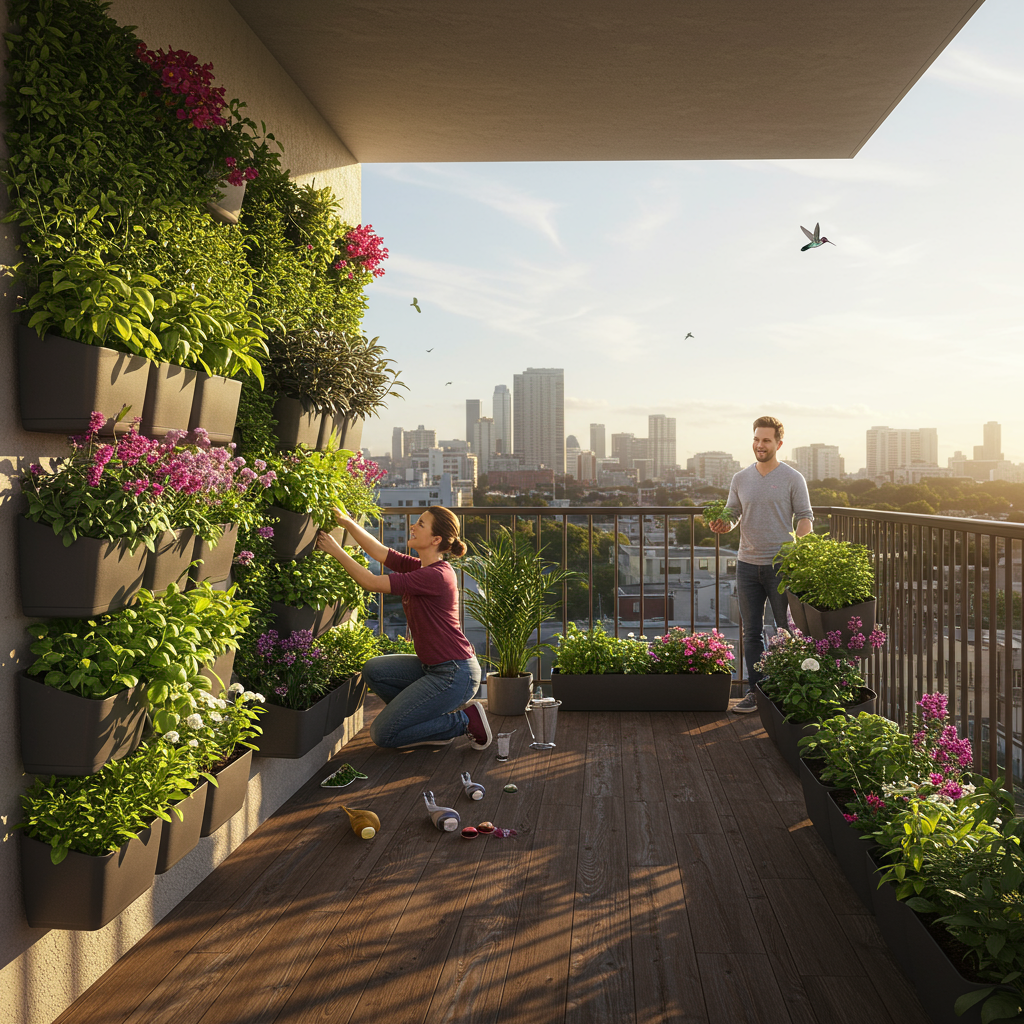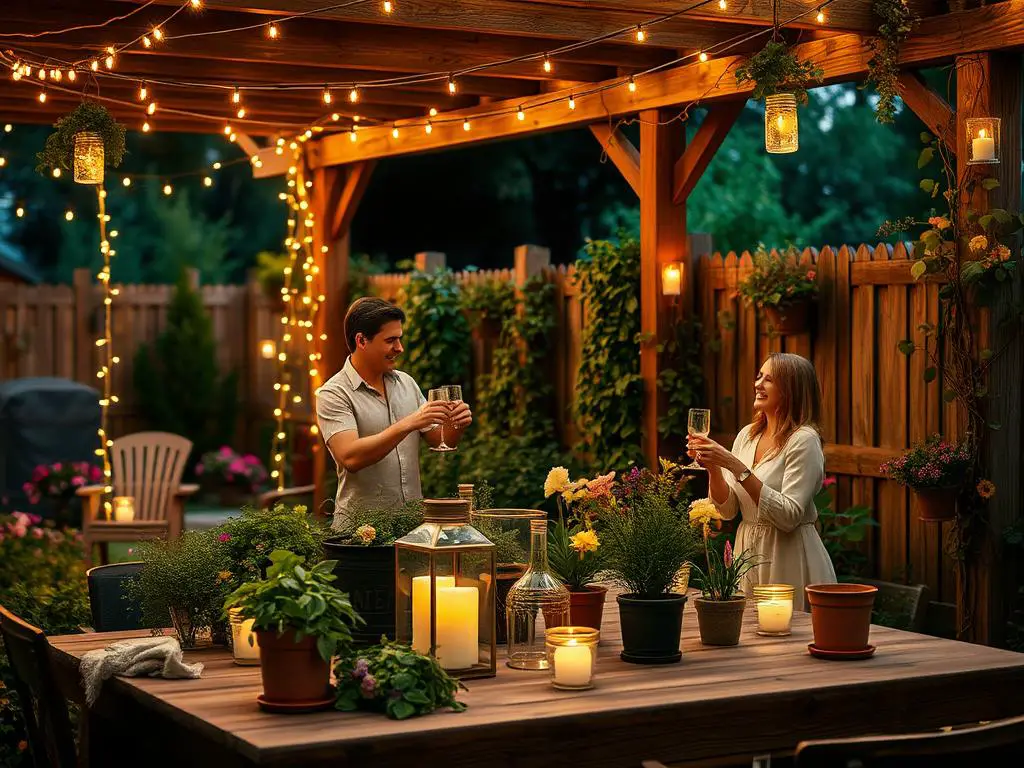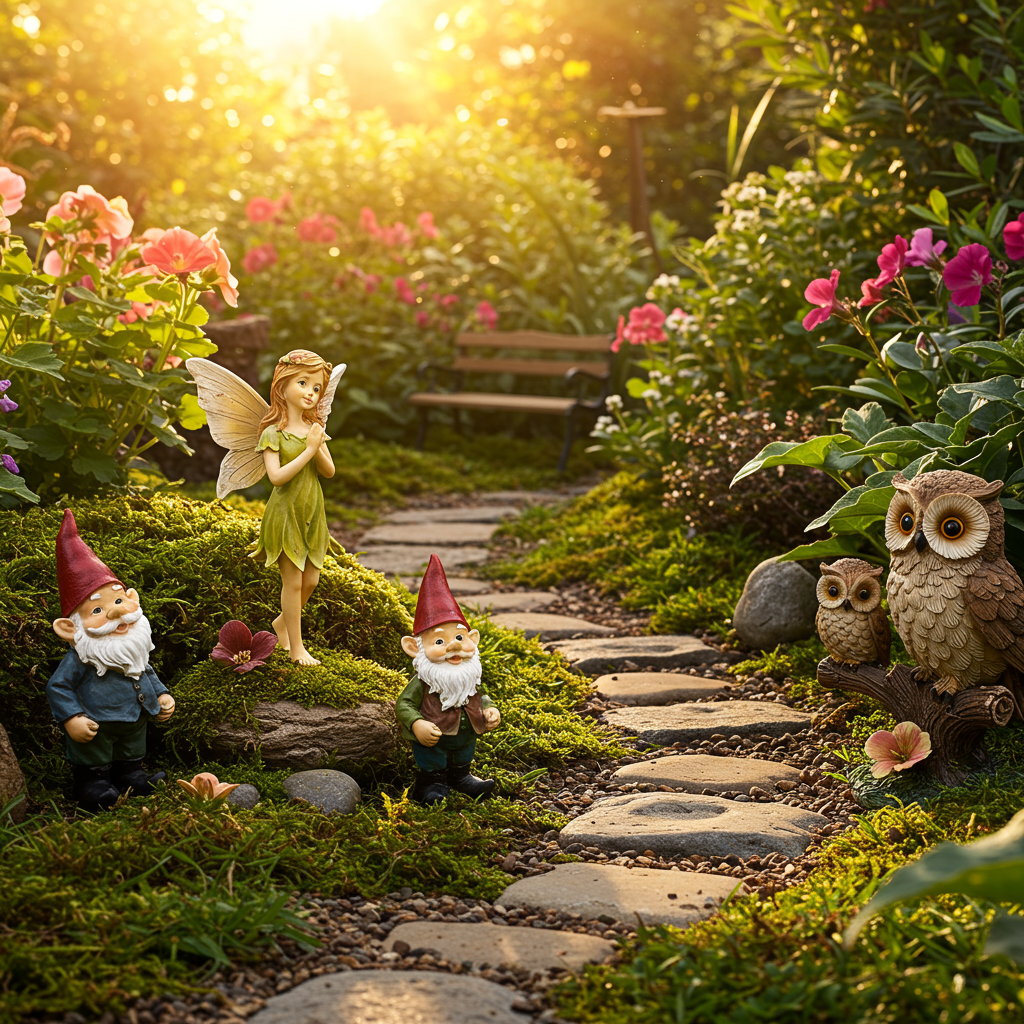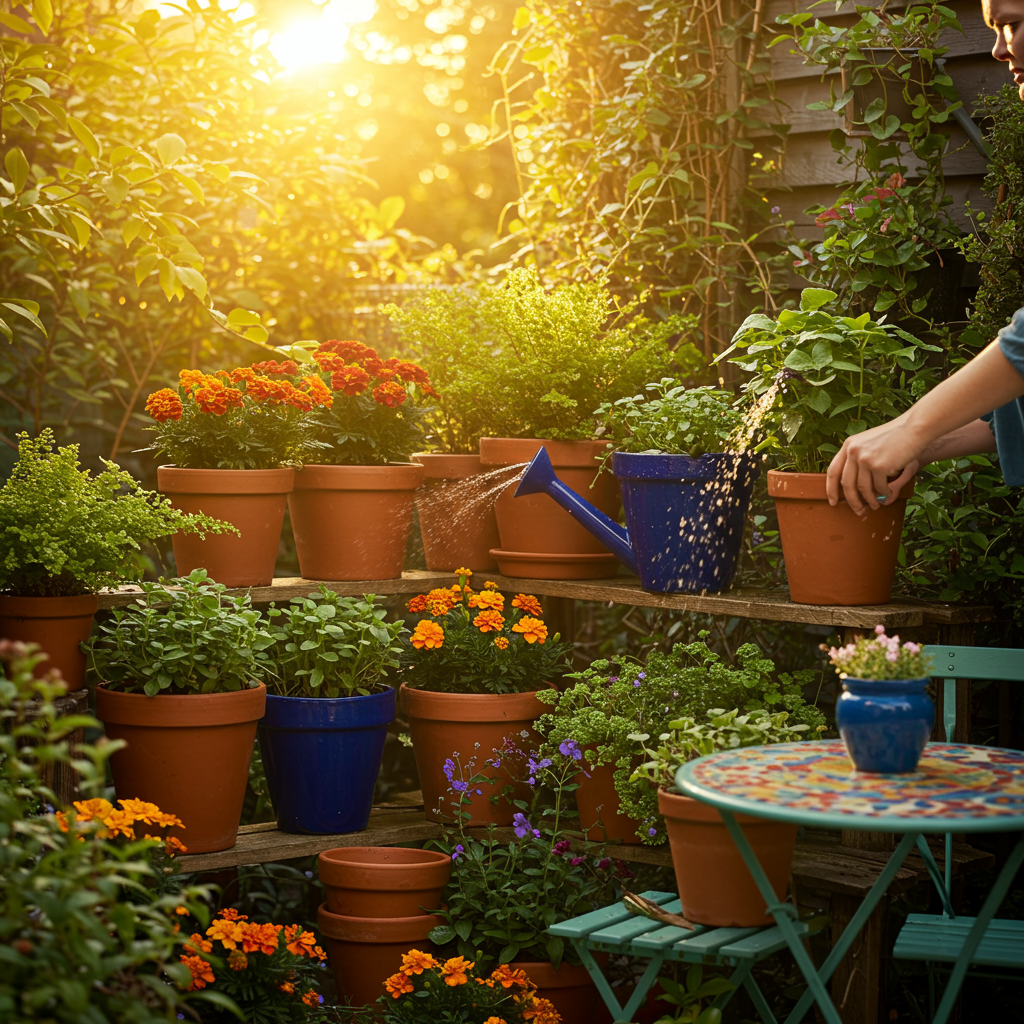Transforming a small garden into a vibrant oasis doesn’t require a lot of space or a hefty budget. With the right decor ideas, even the tiniest outdoor areas can be enhanced to create a warm, inviting atmosphere. Whether you have a balcony, a small backyard, or just a few potted plants on your patio, small decor elements can make a huge difference. In this article, we’ll explore six small garden decor ideas that pack a punch, showcasing how thoughtful design can elevate your garden’s appeal.
“`html
| Feature | Details |
|---|---|
| Decorative Planters | Use unique shapes and colors to enhance visual interest. |
| Garden Lighting | Incorporate solar lights or string lights for ambiance. |
| Vertical Gardens | Maximize space with wall-mounted planters or trellises. |
| Garden Art | Add sculptures or handmade pieces for personality. |
| Pathway Accents | Use stones or decorative borders to define walkways. |
| Seasonal Decor | Change decorations with the seasons for freshness. |
| Water Features | Incorporate small fountains or birdbaths for tranquility. |
“`
1. Vertical Gardens: Going Up for Impact

When space is limited, consider taking your garden to new heights with vertical gardening. Vertical gardens not only maximize your planting area but also create a stunning visual effect. You can use various structures like wall-mounted planters, trellises, or even repurposed wooden pallets to display your plants.
By incorporating climbing plants such as ivy, morning glories, or even herbs like basil and mint, you can add layers of color and texture to your garden. Additionally, vertical gardens can serve as natural privacy screens, enhancing your outdoor space’s intimacy. To further personalize your vertical garden, mix in decorative items such as colorful pots, garden sculptures, or fairy lights to create an enchanting ambiance.
2. Decorative Garden Stakes: Small Yet Striking
Garden stakes are an effortless way to inject personality into your small garden. These decorative elements come in various styles, from whimsical designs featuring animals or flowers to more elegant options like metal or glass art. Strategically placing garden stakes throughout your space can guide the eye and add a focal point to your garden.
For a cohesive look, choose stakes that complement your existing garden decor. You could opt for a specific theme, such as rustic country or modern chic, to create a harmonious atmosphere. Moreover, they can be used to mark plant varieties or simply to brighten up empty spots in your garden, making them functional as well as decorative.
3. Cozy Seating Areas: Create a Retreat
Even in small gardens, creating a cozy seating area can significantly enhance the space’s usability and charm. Consider adding a compact bistro table and chairs, a stylish bench, or even a hammock, depending on your available space. The key is to select furniture that is proportionate to your garden size, ensuring it doesn’t overwhelm the area.
Accessorize your seating with cushions, throws, and outdoor rugs to make the space feel inviting and comfortable. This area can serve as your personal retreat for reading, sipping coffee, or simply enjoying nature. To further enhance the ambiance, consider surrounding the seating with fragrant flowers or hanging plants that provide a sense of enclosure and tranquility.
4. Whimsical Birdhouses: Functional Art
Birdhouses are not just practical for attracting feathered friends; they can also serve as unique garden decor. Available in a myriad of designs, colors, and materials, birdhouses can add a touch of whimsy and charm to your small garden. You can choose from traditional wooden styles or opt for more modern, artistic designs that reflect your personal taste.
Position your birdhouses at varying heights among your plants to create visual interest and encourage birds to visit. Not only do they enhance the aesthetics of your garden, but they also contribute to the local ecosystem by providing shelter for birds. To make them even more appealing, consider adding a small feeder or birdbath nearby, creating a delightful space for both you and your avian visitors to enjoy.
5. String Lights: Illuminate Your Space

String lights are a popular and effective way to add warmth and ambience to any garden setting, especially when space is limited. They can be hung along fences, draped over pergolas, or wrapped around trees to create a magical atmosphere. The soft glow of string lights can transform your small garden into a cozy retreat during the evening hours.
Choose energy-efficient LED lights to minimize electricity usage and consider using solar-powered options for a more eco-friendly approach. You can also opt for themed lights, such as lantern styles for a rustic look or colorful bulbs for a more festive vibe. Whichever style you choose, string lights are sure to create an inviting environment that draws you outdoors, even after sunset.
6. Miniature Garden Statues: Adding Character

Small garden statues can serve as charming accents that reflect your personality and interests. From playful gnomes to sleek modern sculptures, these little pieces can add character and intrigue to your garden. Placing them in strategic locations can create delightful surprises as guests explore your outdoor space.
When selecting statues, consider their size and style to ensure they harmonize with your overall garden theme. You might choose whimsical figures for a fun touch or elegant statues for a more sophisticated look. Additionally, you can pair your statues with plants that complement their color and texture, enhancing their visual impact.
In conclusion, decorating a small garden doesn’t have to be a daunting task. With a few thoughtful additions, you can create a vibrant and inviting space that feels much larger than its actual size. From vertical gardens to cozy seating areas, each of these ideas offers unique ways to enhance your outdoor experience, making every inch of your garden count.
7. Potted Plants: Versatile and Vibrant

Potted plants are a fantastic way to introduce greenery into your small garden without the need for extensive landscaping. They not only allow for flexibility in terms of arrangement but also offer the opportunity to experiment with different plant species and colors. Choose a variety of pots in different sizes, materials, and colors to create visual interest.
Consider grouping pots together in clusters to create a lush effect. This can involve varying the heights of the pots, which adds dimension to your garden. For a cohesive look, you might stick to a particular color palette or material, such as terracotta for a rustic vibe or sleek ceramic for a modern aesthetic. Additionally, incorporating herbs in your potted plants can add both beauty and practicality, providing fresh ingredients for your cooking.
8. Pathways and Edging: Define Your Space
Creating pathways in your small garden can help delineate different areas and add structure to the overall design. You don’t need a grand stone walkway; simple gravel, stepping stones, or even wood chips can create defined paths that enhance accessibility and visual appeal. Paths can lead to seating areas, garden features, or simply meander through your plants, inviting exploration.
Edging can also play a crucial role in defining your garden’s boundaries. Use materials like bricks, stones, or even low-growing plants to create natural borders around flower beds or to separate different sections of your garden. This not only organizes your space but also adds a polished look. Curved edges can soften the appearance, while straight lines can give a more structured feel. Choose the style that best matches your garden’s overall theme.
9. Water Features: Soothing Sounds and Visual Appeal
Incorporating a water feature into your small garden can elevate its charm and create a serene atmosphere. Whether it’s a small fountain, a birdbath, or even a mini pond, the sound of flowing water can be incredibly soothing. Water features also attract wildlife, such as birds and butterflies, enhancing the biodiversity of your garden.
If space is tight, consider a compact tabletop fountain that can be placed on a patio or balcony. For a more integrated approach, you might explore DIY options, such as transforming an old ceramic pot into a small pond. Surround your water feature with stones or plants to create a naturalistic setting. Additionally, adding aquatic plants can enhance the aesthetic appeal and contribute to a balanced ecosystem in your garden.
10. Seasonal Decor: Celebrate the Changing Seasons
One way to keep your small garden feeling fresh and dynamic is by changing out seasonal decor. Embrace the spirit of each season with themed decorations that reflect nature’s changes. In spring, consider adding pastel-colored flowers or Easter-themed ornaments. Summer can be celebrated with vibrant, tropical touches, while fall might inspire pumpkin displays and warm, earthy tones.
Winter can be a bit more challenging, but incorporating evergreen plants or holiday lights can add cheer to your outdoor space. Seasonal decor doesn’t have to be extravagant; small touches can make a big impact. Rotating your decorations can also keep your garden interesting for both you and your guests, making each visit feel like a new experience.
11. DIY Projects: Personal Touches for Your Garden
Engaging in DIY projects can not only save you money but also allow you to infuse your personality into your garden decor. There are countless ideas for small projects that can enhance your garden’s charm. For instance, you could create your own plant markers from painted stones or upcycle old furniture into unique planters.
Another fun idea is to make a mosaic garden table using broken tiles or glass. This not only serves a functional purpose but also acts as a stunning centerpiece for your seating area. If you’re feeling particularly crafty, consider building a small trellis or plant stand to showcase your favorite blooms. The beauty of DIY projects is that they can be tailored to fit your tastes and the specific needs of your garden, creating a space that is uniquely yours.
12. Themed Gardens: A Cohesive Experience
Finally, consider designing your small garden around a specific theme. This can help unify all your decor elements and create a harmonious experience. Popular themes include a cottage garden with a mix of flowers and herbs, a Mediterranean garden featuring terracotta pots and olive trees, or even a zen garden focused on tranquility with rocks, sand, and minimalistic plants.
Choosing a theme can guide your decisions on plants, decor, and layout, resulting in a cohesive look that tells a story. It also allows you to indulge your creativity and interests, making your garden a true reflection of who you are. Themes can change and evolve over time, so feel free to experiment and adjust as you go along!
13. Edible Landscaping: Grow Your Own Food
Incorporating edible plants into your garden not only beautifies the space but also provides fresh produce right at your doorstep. Edible landscaping is a creative way to blend aesthetics with functionality. You can grow vegetables, fruits, and herbs alongside traditional ornamental plants, creating a lush and productive environment.
Start by selecting easy-to-grow plants that can thrive in your local climate. Herbs like basil, parsley, and rosemary can be planted in decorative pots or woven into flower beds. For a splash of color, consider growing vibrant peppers or heirloom tomatoes, which can also serve as striking focal points. If you have limited space, vertical gardening techniques can be applied to edibles, allowing you to maximize your growing area while keeping your garden visually appealing.
Another innovative approach is to plant edible flowers, such as nasturtiums or pansies, which can add both beauty and flavor to salads. Incorporating these plants into your small garden not only promotes sustainability but also encourages a healthy lifestyle, making your outdoor space both a feast for the eyes and the palate.
14. Garden Mirrors: Expanding Perspectives
Using mirrors in your garden can create the illusion of more space and add an interesting visual element. Mirrors reflect light and greenery, making your small garden appear larger and more dynamic. You can place a mirror against a fence, within a trellis, or even frame it with climbing plants to create a stunning focal point.
Choose mirrors with unique frames that complement your garden style—rustic wooden frames for a cottage look or sleek metal for a modern vibe. Additionally, consider placing mirrors strategically near seating areas to catch the light and reflect beautiful blooms. This touch can enhance the overall ambiance and invite guests to explore the depths of your garden.
15. Aromatic Herbs: Engage the Senses
Adding aromatic herbs to your garden can engage the senses and transform your outdoor space into a fragrant retreat. Herbs like lavender, mint, and thyme not only provide delightful scents but can also attract pollinators and beneficial insects, enhancing the biodiversity of your garden.
To maximize the sensory experience, consider creating an herb spiral or dedicated herb garden in pots. This allows you to grow a variety of herbs in a compact space while also making it easy to access them for cooking or tea. You can further enhance this area by using decorative containers or labels to identify each herb, adding both charm and functionality to your garden.
16. Garden Art: A Creative Expression
Incorporating various forms of garden art can add an imaginative and personal touch to your outdoor space. From colorful mosaics to artistic plant pots, garden art showcases your personality and can become conversation starters for guests. Look for sculptures, wind chimes, or even DIY projects that reflect your interests and style.
Consider creating a small gallery by grouping different pieces together. This can include handmade crafts, pottery, or even repurposed materials turned into art. If you’re feeling adventurous, you might even experiment with outdoor painting, creating your own mural or decorative wall that complements the surrounding flora.
17. Trellises and Arches: Create Height and Drama
Adding trellises or arches to your small garden can introduce vertical interest and create a stunning backdrop for climbing plants. These structures not only support plants like roses and clematis but also create a sense of enclosure and intimacy within your garden.
Position a trellis along a wall or fence to provide an attractive frame for your climbing plants, or use an archway as a gateway to different sections of your garden. Decorate these structures with seasonal blooms or fairy lights to enhance their appeal. The combination of greenery and structure can add elegance and drama, transforming your garden into a picturesque retreat.
18. Outdoor Rugs: Define Spaces and Add Comfort
Outdoor rugs can play a significant role in defining areas and adding warmth to your garden. They create cozy zones for seating, dining, or relaxing, making your outdoor space feel more like an extension of your home. Choose weather-resistant rugs that can withstand the elements while adding a splash of color or pattern to your garden.
When selecting a rug, consider the size and shape that best fits your furniture arrangement. A large rug can anchor a seating area, while smaller ones can highlight specific features like a garden bench or pot display. This simple addition can enhance the overall comfort and style of your garden, inviting you and your guests to linger and enjoy the surroundings.
19. Compost Bins: Eco-Friendly Decor
Integrating a compost bin into your garden can be both a practical and eco-friendly decor choice. Not only does it help reduce waste, but it also provides nutrient-rich soil for your plants. Fortunately, compost bins come in various styles, from simple DIY options to aesthetically pleasing store-bought versions that can blend seamlessly into your garden design.
Position your compost bin in a discreet location, perhaps near a vegetable or herb garden, where it can be easily accessed. You can also decorate the area around the bin with ornamental plants or signage to make it more attractive. This sustainable addition can serve as a conversation piece while promoting environmental responsibility in your gardening efforts.
20. Garden Workshops: Creating a Community Space
Consider dedicating a small area of your garden to host workshops or gatherings. This could be a space for community gardening events, crafting sessions, or even cooking classes featuring your homegrown produce. By creating a workshop space, you not only enhance the functionality of your garden but also foster a sense of community and connection with others.
Set up a simple table and chairs, and decorate the area with string lights or lanterns for a welcoming atmosphere. Consider incorporating a chalkboard for announcements or theme-related decor that changes with the seasons or events. This multifunctional space can transform your small garden into a vibrant hub for creativity and learning.
